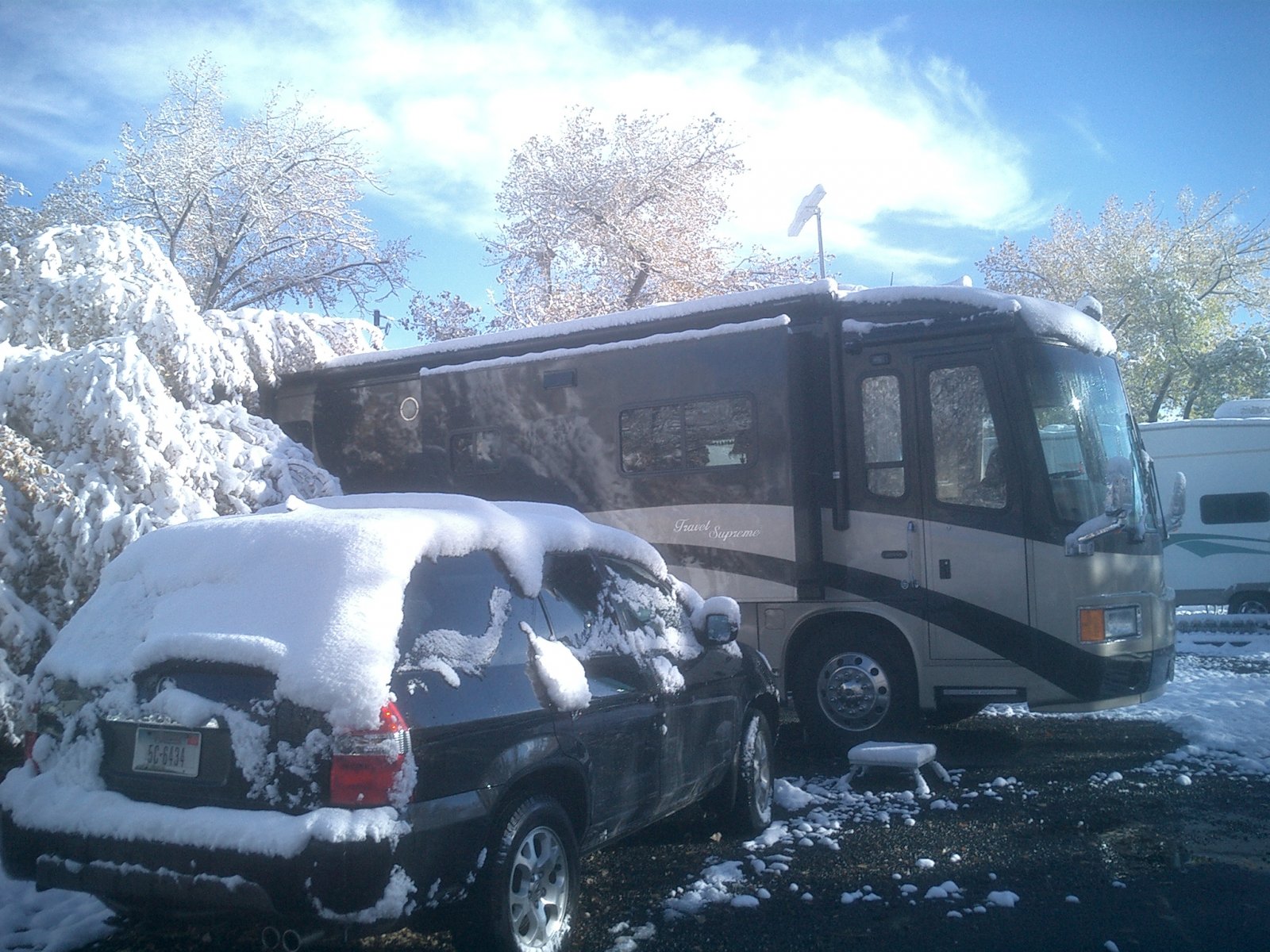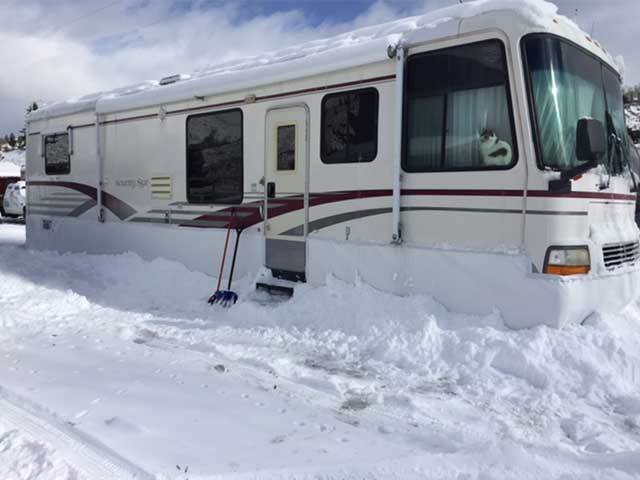
Cold weather camping can be fun! (Image: @buskipper, iRV2 Forums)
Enjoy the Season with these Winter RVing Pro Tips
Some RV snowbirds flock to snow, not away from it. In these winter RVing tips, these experts show that RVing in cold temperatures is an art that anyone can master. Here’s how.
You don’t need an expensive RV with heated basements, or a lot of money to tackle a cold-weather RV camping experience. All you need to make it through winter is a willingness to learn the capabilities and limitations of your own RV before getting caught in freezing weather.
You’ll need to understand your RV systems, experiment with different types of cold weather insulation, and talk with others who’ve been there, done that. To get you started, these experienced winter RVers offer their best winter camping tips to keep you and your RV safe when temperatures drop.
Use a heated RV water hose
Water hoses freeze fast without extra precautions. In this iRV2 Winter Camping Thread, senior forums member @FatChance shares ten critical winter camping tips. Based on his experience in his 2004 Newmar Mountain Aire 4016, 400ISL, he recommends (among many other great tips) using a heated water hose, heat tape, and a “Thermocube” Outlet:
A Camco “Freeze Ban” heated water hose and heat tape on the metal pipe on the fresh water spigot. I power them off the power pedestal using a Thermocube outlet (turns on when it gets down to 35* and off when it gets up to 45*). I also put an orange Home Depot bucket over the spigot to keep the electrics dry and to hold in a little heat over the spigot. So far, this has worked to keep the water flowing even when it gets down into the teens. In single digits, I turn off the water as a precaution and use the water tank (always keep it full), but no problems yet.
Staying put? Winter RV skirting is helpful
Skirting your RV in winter can also help if you’re not going anywhere. According to iRV2 Forums member GramPa Carso:
I lived in AK. for 13 years. Two years in a TT. I used the blue foam that is two inches thick. Make a frame the size of your rig with 2×4 on the ground. Attach the foam to the frame and use wire or light chain just under the rig going across and attaching the two sides together. Remember to make a hole that is closeable to dump. I used 4×8 ft. foam. It went up 4 ft. on the sides. Do not cover the heater vents. I had an electric heater under the TT.

When your wheels don’t roll, reach for skirting. (Image: @chinewalker, iRV2 Forums)
Keep cold RV floors warm
If your RV floor is cold, everything else feels chilly too. When you don’t have an RV with heated floors, here’s an interesting tip to warm up your home, from iRV2 member @Off_Road:
I bought some foam grey squares, used for stress relief when people have to stand for long periods. They connect like puzzle pieces and I cut them to cover the floor. This kept our feet warm and helped insulate the floor.
Minimize humidity
Humidity rises when indoor temperatures go down. Daily living like cooking and showering trap moisture inside your RV. Eventually, uncontrolled humidity in RVs can lead to big problems like moisture damage and rust. When RVing in cold weather, do all you can do to minimize humidity. iRV2 member R.B. offers these tips:
I strongly recommend a dehumidifier. Humidity skyrockets quickly in the winter, and when it condenses on cold surfaces, it’s a recipe for mold if it happens often enough. A good dehumidifier serves two purposes: humidity removal and a circulation fan for the air.
Do not waste your money on desiccant packs or countertop dehumidifiers. They do almost nothing and just take up space. If you go the dehumidifier route, get one with a compressor (the countertop ones just have a cold plate). We carry a 70-pint Frigidaire.
Know your local resources
Winter RVing can be tough on even the best RV systems. Hopefully, your pipes won’t freeze or break, but to prepare for the worst of winter, iRV2 member @RV Dude has smart advice for anyone who is staying put in a cold climate:
If you are parked in a cold area, scope out accessible fuel sources and propane filling options. Get RV service phone numbers and taxi phone numbers in advance. Know what the local hardware store has in terms of supplies for the DIY’er. Check out the local auto and truck parts stores (if any) so you know what options you have. In the cold, time is of the essence; you can’t put off fixing a critical component or miss a warmer weather window for a repair while looking for all this info.
Winter RVing tips make cold weather easier
If you’re up for an adventure, winter camping is waiting for you. It’s not always the easiest kind of experience, but if you follow the advice of more experienced RVers, your next cold weather RVing trip will be more comfortable than you imagined.
Head over to iRV2.com for more tips from experienced RVers. You may also want to check out these great resources:
- 5 Misconceptions About Winter Camping
- 5 Easy Recipes For Winter Camping
- The Best Winter Camping Gear For RVers
- How To Keep Your RV Plumbing From Freezing When Winter Camping
- How To Avoid Winter Camping Problems In Your RV
- Maintaining Power And Healthy Batteries When Winter Camping

Nearly all points mentioned in this article are spot on. The problem is they are addressed to the wrong people: the owners. They should be addressed to the MANUFACTURERS! You would not put up with winter fiascos from your car. So automobile manufacturers provide an all-season climate control system in even the cheapest vehicles. The simple solution for winter RV operations is to demand 4 season capability from the manufacturer and test before purchase.
Thanks for the info. I’m a new RV owner with a lot to learn. But I am so excited about the new experience with this bohemith vehicle. It is doing well so far. I hope that it will serve me well. I bought it brand new, and would you believe it, one of the first articles that I read was ” Not to Buy a New RV!” Boy did that make me nervous. I am still happy that I bought this for myself. Thanks for the winter information. I look forward to reading more.
Well, a weekend stay is hardly ‘Winter RVing’; IMHO. Thanks for the tips though. There are blue water hoses that are warmed, so no need to worry about fresh water intake, other than we do have tanks: refilling should/could be a one time action whenever running low, not need to be permanently attached to water. Same for sewer line: just bring the TT next to the dump (or just connect) when getting full, not all the time. Skirt is important unless… you place tank and elbow (by the sewer discharge port) warmers that operate on 12V. Then, as long as your batteries have juice or you are connected to city power/generator, no need of skirting. Carry the largest propane tanks your TT/tongue weight capacity of your TV allow. Contrary to most, I believe (and experience) 4 seasons RVing with my Airstream.